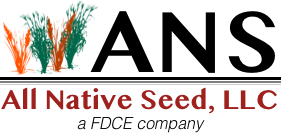
How CRP plantings and other native landscapes can create essential corridors for wildlife movement and biodiversity preservation
As development and land-use change continue to fragment natural landscapes, wildlife populations face growing challenges in accessing the resources they need to survive. Roads, urban sprawl, and agricultural conversion often cut off animals from food, water, mates, and shelter, leading to isolated populations and reduced biodiversity. One of the most effective ways to counteract this fragmentation is by establishing wildlife corridors; continuous stretches of habitat that allow animals to move safely between larger habitat patches.
For landowners enrolled in the Conservation Reserve Program (CRP) or those looking to support wildlife conservation on their property, planting native grasses and forbs is a powerful tool to help reconnect fragmented landscapes. At All Native Seed, we provide high-quality, tested native seed mixes that contribute directly to wildlife corridor creation and biodiversity preservation.
What Are Wildlife Corridors?
Wildlife corridors are areas of native habitat that serve as natural highways for animals. These corridors:
- Facilitate safe movement between isolated habitats
- Support seasonal migration and daily travel
- Increase genetic diversity by connecting separated populations
- Reduce the likelihood of human-wildlife conflict
Corridors can take many forms, including riparian buffers, fencerow plantings, roadside native vegetation, or full-scale CRP fields. The unifying factor is that they are composed of native plant species that offer food, shelter, and safe passage for a wide range of wildlife.
How Native Plants Create Effective Corridors
Native plants are the foundation of healthy ecosystems. When used strategically, they support a broad spectrum of wildlife, including mammals, birds, amphibians, and beneficial insects.
1. Diverse Habitat Structure
Native plantings, especially those with a mix of grasses and forbs, offer vertical and horizontal habitat diversity. This layered structure provides:
- Ground-level cover for small mammals and reptiles
- Mid-height vegetation for nesting birds
- Nectar-rich flowers for pollinators and insects
This complexity is essential for maintaining corridors that support a variety of species across the food chain.
2. Continuous Food Supply
Different species of native plants bloom at various times throughout the year, ensuring a steady supply of resources. For example:
- Partridge Pea and Purple Coneflower attract pollinators and seed-eating birds
- Big Bluestem and Switchgrass provide forage and seed for wildlife
- Goldenrod and Asters bloom late into the season, helping sustain insects in the fall
This diversity encourages year-round use by wildlife and boosts the functionality of the corridor.
3. Safe Passage
Corridors help animals travel safely by avoiding open agricultural fields or urban spaces. CRP plantings of native species create natural buffers that minimize exposure to predators and traffic, especially for species like:
- Quail and pheasants
- Rabbits and small mammals
- Migratory songbirds
CRP and Wildlife Corridor Development
The USDA’s CRP program offers several practices that are ideal for wildlife corridor development, including:
- CP33 (Habitat Buffers for Upland Birds)
- CP42 (Pollinator Habitat)
- CP4D (Permanent Wildlife Habitat)
When implemented thoughtfully, these practices not only fulfill conservation goals but also serve as links between larger habitat areas, such as forests, wetlands, or prairies.
Landowners can maximize corridor effectiveness by:
- Selecting site-appropriate native seed mixes
- Avoiding the use of pesticides and unnecessary mowing
- Coordinating with neighbors or conservation agencies to expand connectivity
All Native Seed: Your Partner in Habitat Connectivity
At All Native Seed, we’ve helped plant more than 400,000 acres of native habitat across the U.S. We understand the critical role native plants play in wildlife conservation and are committed to helping landowners design seed mixes that promote ecological success.
Our team offers:
- NRCS-compliant seed mixes tailored for corridor development
- Boost-treated seed for higher germination and survival
- Expert guidance on CRP practice selection, planting, and maintenance
Building a Better Future for Wildlife
Wildlife corridors are more than conservation tools, they’re lifelines for biodiversity. Whether you’re managing land through CRP or seeking to improve habitat on your own property, native plants are the key to reconnecting fragmented landscapes and preserving wildlife for generations to come.
Get in touch with All Native Seed today to learn how we can help you build corridors that make a real difference.
